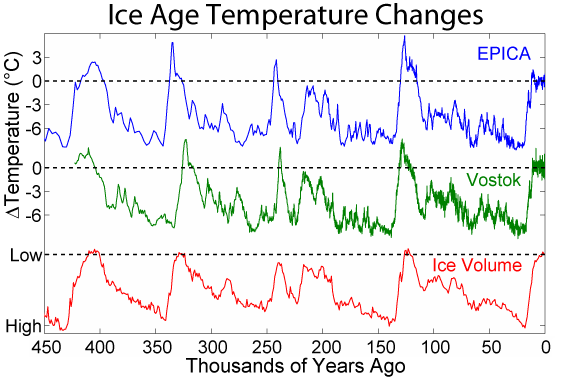The Climategate team removed the warm 1940's "blip", erased the Medieval Warm Period, Hid the Decline, and tortured temperature & sea level data until it confessed, but a paper published today in Earth's Future could take the cake by suggesting removal of "the Holocene Epoch from the geologic timescale" and replacing it with the fictitious, scary-sounding "geologic" timescale "The Anthropocene."
Excerpt from "Hello Anthropocene, Goodbye Holocene":
: "As the official timescale keepers deliberate the introduction of the Anthropocene and a Holocene-Anthropocene boundary (Anthropocene Working Group of the Subcommission on Quaternary Stratigraphy; Zalasiewicz, J., M. et al., 2010; http://goo.gl/wIm6X0 ), they should consider the alternative: Remove the Holocene Epoch from the geologic timescale. Whereas any timescale change is a contentious issue, let alone changes to an existing epoch, modern human society’s interactions with its planet and ecosystems, embodied by the Anthropocene, are sufficiently large to produce a lasting geologic marker that supports such modification. This new boundary would remain visible in the geologic record of oceans and continents (see also Corcoran et al., 2014 on plastics), meeting the stratigraphic requirements that ultimately underlie the timescale and marking a shift from the Pleistocene’s Milankovitch forcing to the Anthropocene’s human forcing.
The Holocene is a climate-centric placeholder for change after the latest Quaternary glaciation, but does not, as defined, match the accelerated changes in land, ocean and atmosphere that mark modern times. So, I suggest that (a) we remove the Holocene altogether in favor of a (young) Anthropocene Epoch that reflects planet-wide geologic changes since c. 1900 CE, or (b) we demote the Holocene to Stage/Age status, marking the end of the Pleistocene Epoch. The latter, perhaps more palatable compromise, would recognize historical precedent and allow continued use of Holocene in the literature as a temporal (“Age”) marker. Regardless, slicing the Quaternary Period in ever thinner epochs has no geologic merit. Given the degree and impact of modern, human-induced changes on our planet, a young Pleistocene-Anthropocene boundary seems justified."The journal titled The Holocene probably isn't going to like this idea.
The fact is the tiny 0.7C recovery since the end of the Little Ice Age in ~1850, which is coincidentally when the global temperature record begins, could easily be natural and 95% explained by solar activity and ocean oscillations, and is not unprecedented or unusual within the past ~10,000 years of the Holocene Epoch. Thousands of paleoclimate papers show the Medieval, Roman, Egyptian, Minoan, and multiple other unnamed warm periods within the Holocene were warmer than the present. In addition, the Pacific Ocean has been significantly warmer than the present throughout vast majority of the Holocene.
Further, during the last interglacial ~120,000 years ago, Greenland was up to 8C warmer than the current interglacial warm period, and sea levels were up to 29 feet higher. Therefore, there is no evidence that warmth during the current interglacial warm period is unprecedented, unusual, or unnatural.
Therefore, there is no valid reason whatsoever to remove the Holocene Epoch "blip" from the geological timescale, despite how convenient it would be for the climate propagandists. Kinda bad timing too promoting the silly Anthropocene/Mannocene notion that man-made CO2 controls the climate given the 50+ excuses for the absence of global warming for the past 18-26 years despite a steady rise in CO2.
 |
| GISP2 Greenland ice core data in blue, the tiny 0.7C "Anthropocene" warming of HADCRU sea surface temperatures to present-day shown in red spliced at end |
 |
| Above GISP2 Greenland ice core data with labeled warm periods |
 |
| Present Greenland temperatures haves been exceeded many times over past 4000 yrs Full paper |
 |
| Temperatures during the last interglacial period ~120,000 years ago [and several other interglacials] were higher than during the present interglacial period. |
 |
| Holocene Epoch shown at lower right, as well as the lack of correlation on geologic timescales between CO2 and temperature. |
 |
| On geologic timescales, we are still in an ice age, because there are ice sheets present at both poles |
No name change is needed. Just assume the Pleistocene is going to continue for another million years or so and this is just another interglacial stage/age.
ReplyDeleteThe Hockey Schtick writes:
ReplyDelete"GISP2 Greenland ice core data in blue, the tiny 0.7C “Anthropocene” warming of HADCRU [sic] sea surface temperatures to present-day shown in red spliced at end"
"HADCRU" (actually HADCRUT) includes sea surface temperature data but it is not only sea surface temperature. HADCRUT also includes CRUTEM land surface temperature data--thus the CRU in HADCRUT.